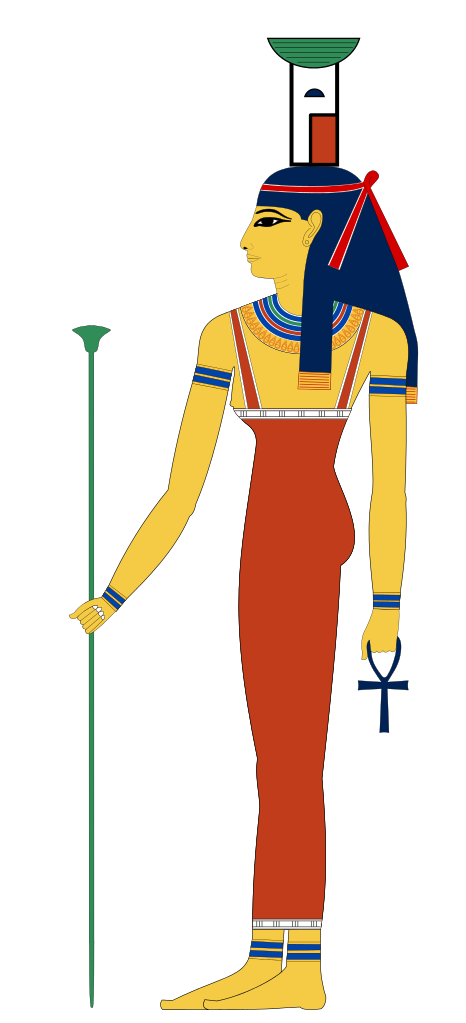Nephthys
Nephthys or Nebet-Het in ancient Egyptian was a goddess in ancient Egyptian religion. A member of the Great Ennead of Heliopolis in Egyptian mythology, she was a daughter of Nut and Geb. Nephthys was typically paired with her sister Isis in funerary rites because of their role as protectors of the mummy and the god Osiris and as the sister-wife of Set.
She was associated with mourning, the night/darkness, service (specifically temples), childbirth, the dead, protection, magic, health, embalming, and beer.
The fifth day of the intercalary week of the Egyptian calendar was devoted to celebrating her birthday.
Etymology
Nephthys is the Greek form of an epithet (transliterated as Nebt-het, from Egyptian nbt-ḥwt). The origin of the goddess Nephthys is unclear but the literal translation of her name is usually given as "Lady of the House or Lady of the Temple."
This title, which may be more of an epithet describing her function than a given name, probably indicates the association of Nephthys with one particular temple or some specific aspect of the Egyptian temple ritual. Along with her sister Isis, Nephthys represented the temple pylon or trapezoidal tower gateway entrance to the temple which also displayed the flagstaff. This entrance way symbolized the horizon or akhet.
Role
At the time of the Fifth Dynasty Pyramid Texts, Nephthys appears as a goddess of the Heliopolitan Ennead. She is the sister of Isis and companion of the war-like deity, Set. As sister of Isis and especially Osiris, Nephthys is a protective goddess who symbolizes the death experience, just as Isis represented the birth experience. Nephthys was known in some ancient Egyptian temple theologies and cosmologies as the "Helpful Goddess" or the "Excellent Goddess." These late ancient Egyptian temple texts describe a goddess who represented divine assistance and protective guardianship.
Nephthys is regarded as the mother of the funerary deity Anubis in some myths. Alternatively Anubis appears as the son of Bastet or Isis. In Nubia, Nephthys was said to be the wife of Anubis.
Though usually considered the aunt of Horus, she often appears as his mother. She is also seen as a wife of Horus. As the primary "nursing mother" of the incarnate pharaonic god, Horus, Nephthys also was considered to be the nurse of the reigning pharaoh himself. Though other goddesses could assume this role, Nephthys was most usually portrayed in this function. In contrast, Nephthys is sometimes featured as a rather ferocious and dangerous divinity, capable of incinerating the enemies of the pharaoh with her fiery breath.
It is Nephthys who assists Isis in gathering and mourning the dismembered portions of the body of Osiris after his murder by the envious Set. Nephthys also serves as the nursemaid and watchful guardian of the infant Horus. The Pyramid Texts refer to Isis as the "birth-mother" and to Nephthys as the "nursing-mother" of Horus.
Nephthys was attested as one of the four "Great Chiefs" ruling in the Osirian cult center of Busiris in the Delta and she appears to have occupied an honorary position at the holy city of Abydos. No cult is attested for her there, though she certainly figured as a goddess of great importance in the annual rites conducted, wherein two chosen females or priestesses played the roles of Isis and Nephthys and performed the elaborate "Lamentations of Isis and Nephthys." There, at Abydos, Nephthys joined Isis as a mourner in the shrine known as the Osireion. These "Festival Songs of Isis and Nephthys" were ritual elements of many such Osirian rites in major ancient Egyptian cult centers.
Nephthys could also appear as one of the goddesses who assists at childbirth. An ancient Egyptian myth preserved in the Papyrus Westcar recounts the story of Isis, Nephthys, Meskhenet, and Heqet as traveling dancers in disguise, assisting the wife of a priest of Amun-Ra as she prepares to bring forth sons who are destined for fame and fortune.
Symbolism
In the funerary role, Nephthys often was depicted as a kite or as a woman with falcon wings, usually outstretched as a symbol of protection. Nephthys's association with the kite or the Egyptian hawk (and its piercing, mournful cries) evidently reminded the ancients of the lamentations usually offered for the dead by wailing women. In this capacity, it is easy to see how Nephthys could be associated with death and putrefaction in the Pyramid Texts. She was, almost without fail, depicted as crowned by the hieroglyphs signifying her name, which were a combination of signs for the sacred temple enclosure (ḥwt) along with the sign for nb or mistress (lady) on top of the enclosure sign.
Nephthys was clearly viewed as a morbid-but-crucial force of heavenly transition, i.e., the pharaoh becomes strong for his journey to the afterlife through the intervention of Isis and Nephthys. The same divine power could be applied later to all of the dead, who were advised to consider Nephthys a necessary companion. According to the Pyramid Texts, Nephthys, along with Isis, was a force before whom demons trembled in fear and whose magical spells were necessary for navigating the various levels of Duat, as the region of the afterlife was termed.
